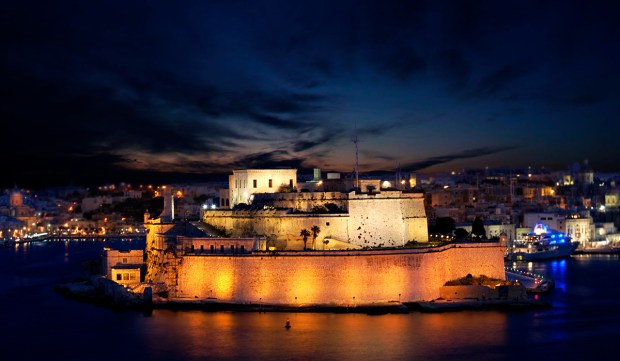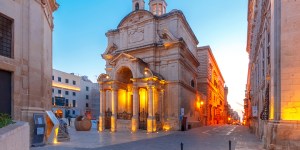Lenten Campaign 2025
This content is free of charge, as are all our articles.
Support us with a donation that is tax-deductible and enable us to continue to reach millions of readers.
In the heart of the Mediterranean, the small island of Malta played a pivotal role in medieval and early modern history. Its strategic location made it a coveted prize for various powers, and its people, known for their resilience and unwavering faith, faced numerous challenges and triumphs throughout this period.
Since the very early days of Christianity, the Maltese were (and still are) deeply devout Catholics, and their faith gave them strength and comfort amid the turmoil of their times.
Since its construction as a fortification in the late 13th century, the impressive Castrum Maris, now known as Fort Sant Angelo, with its towering walls and sacrosanct atmosphere, became a beacon of hope for many – a place where they could find both physical and spiritual refuge and solace.
In 1425, the Maltese people got tired of the oppressive rule of the feudal Aragonese nobleman Gonsalvo Monroy. Rising up in revolt, they demanded better governance and protection from the frequent Moorish attacks. The rebellion spread like wildfire, forcing Monroy and his wife to seek refuge within the walls of the Castrum Maris.

King Alfonso V, enraged by this defiance, sent an army to put down the rebellion. But the Maltese, united in their resolve, raised 30,000 guilders to buy their freedom from Monroy’s oppressive rule. In 1428, King Alfonso had no choice but to recognize the indomitable spirit of the Maltese people, granting them self-government and enshrining their right to rebel in perpetuity.
Despite this victory, the Maltese faced other challenges. In 1429, the Hafsids of Tunisia besieged Malta. While the Maltese and Aragonese forces repelled the Hafsid siege, it was a costly victory, leaving Malta severely damaged, with around 3,000 Maltese citizens taken captive. The Augustinians, who had initially settled in Malta at the Sanctuary of Our Lady in Mellieha, were forced to relocate to Rabat fuor le mura of Mdina after their sanctuary was plundered by the retreating Hafsids. The Hafsids continued to pose a threat to Malta and its surrounding waters, expanding their control over Aragonese territories in North Africa.
In 1432, King Alfonso V led a military campaign against the Hafsids in Djerba. This was followed by another expedition against Tripoli in 1434. Upon his return from the Djerba expedition, King Alfonso V paid a visit to Malta, where he met with the Inguanez family in Mdina and visited the Sanctuary of Our Lady in Mellieha, alongside several bishops.
Even in the face of adversity, the faith of the Maltese people remained unshaken – as the Castrum Maris did, and still does.
The ancient Castrum Maris
Castrum Maris, the fortress that had witnessed their rebellion and stood as a symbol of their resilience, became an even more sacred place, a testament to their unwavering faith in the midst of life’s trials. Today, as Malta becomes a popular tourist destination, Castrum Maris continues to welcome visitors and offer a glimpse into the island’s rich history and the enduring spirit of its people.
The ancient Castrum Maris stands majestically at the tip of the Birgu peninsula, its imposing presence protecting the city’s maritime hub. Behind its formidable ramparts, a thriving community grew up, attracting Angevins, Catalans, Sicilians, and merchants from all over Christendom. This bustling settlement, which had no official name, was referred to simply as The Castle, giving rise to its Italian nickname il Borgo and Maltese equivalent, Il-Birgu.
When the Order of the Knights of St. John the Baptist fortified Malta, they recognized the strategic importance of Fort Sant Angelo and transformed it into a formidable artillery fortress. Historical records indicate that Birgu and the fort developed separate parishes, one dedicated to St. Lawrence the Martyr (San Lorenzo a Mare) and the other to the Virgin Mary. However, the extent of their jurisdiction over each other remains unclear.
An inventory of 1274 shows that the castrum was already served by two churches, one dedicated to the Divine Mother (Mater Dei) and the other to Saint Angelo. This document also mentions artifacts that were already considered relics in 1274. In the 13th century, the chapel was dedicated to the Presentation of the Blessed Virgin (Madonna tal-Gandlora), later renamed Our Lady of Perpetual Help (Madonna tas-Sokkors) in the 15th century, and finally to the Nativity of the Virgin.

The Church of the Nativity of the Blessed Virgin Mary is a testament to the enduring presence of Christianity in the archipelago, as it possibly dates back to Paleo-Christian times. Its ancient semi-troglodyte construction suggests a long-standing religious tradition. Prior to the construction of the castrum, the site was home to a temple dedicated to Astarte – the Phoenician and Carthaginian goddess of the stars. When the Romans arrived, the temple was converted into a shrine to Juno, the Roman goddess of the sky and the moon. This reflects the historical practice of Christianizing pagan temples after the legalization of Christianity in the Roman Empire. A notable example is the transformation of the temple of Diana in Ephesus into a shrine to the Virgin Mary after the Third Council of Ephesus confirmed her status as the Theotokos, the Mother of God.
Mellieha: A haven of devotion and resilience
The village of Mellieha stands as a testament to the island’s rich history and resolute faith. Its most revered landmark, the Sanctuary of Our Lady of Mellieha, embodies the deep-rooted spirituality of the Maltese people and their deep Marian devotion, serving as a beacon of hope for centuries.
Legend has it that Saint Paul and Saint Luke were the first pilgrims to visit the cave that is now the National Shrine of the Blessed Virgin of Mellieha. The earliest Mater Dei image has traditionally been attributed to St. Luke (in the 1st century AD) although the fresco that currently adorns the cave is of late Siculo-Byzantine origin, dating back to the 13th century.
The Virgin Mary is depicted in the fresco as the Hodegetria –the one who shows the way to the Savior. It is highly probable that Christian practice at the site predates, by far, the 13th century fresco: there is a tradition that in AD 409, several Catholic Bishops consecrated the cave as a church, an event depicted in a mural on the cave’s ceiling. This would have occurred close to the Council of Ephesus in AD 431, when the Blessed Virgin was universally recognized as Theotokos, the Mother of God.

Throughout the ages, pilgrims from all over the Mediterranean have flocked to the Sanctuary of the Nativity of the Blessed Virgin to pray and seek her blessings. Many ex-voto offerings, testaments to answered prayers, can be found in the sacristy. A conservation and restoration project in 2013-2016 revealed hidden secrets within the Holy Icon, including the inscription “MAT DEI” (Mother of God) on either side, a flower on the Madonna’s forehead symbolizing her eternal virginity, pearls on the halos representing light and brightness, and traces of dark color on the Child’s halo forming a cross within it, a symbol found in many Byzantine representations of Christ. The original color of the Madonna’s veil was a strong reddish hue, also known as imperial purple –associated with royalty.
The Sanctuary is one of 20 National Marian Shrines that form the European Marian Network. It is also a member of the Association Mary, Mother of Europe and was designated as the National Shrine of Our Lady for the Archdiocese of Malta in 2015.
Over the centuries, the sanctuary has undergone numerous restorations, while retaining its unique charm. The fresco of the Virgin Mary, though faded and weathered, exudes an aura of holiness. The interior of the church, with its vaulted ceilings, stained glass windows and marble altar, offers a glimpse of Malta’s rich artistic heritage.
The Sanctuary of Our Lady of Mellieha has served not only as a place of worship but also as a refuge for the Maltese people in times of need. In 1425, when the island was besieged by the Hafids, the Maltese sought protection within the walls of the sanctuary. This resilience and devotion has been passed down through generations, making the Sanctuary a symbol of Maltese identity.
Today, the Sanctuary of Our Lady of Mellieha is a popular place of pilgrimage, attracting visitors from all over the world. Its tranquil atmosphere and spiritual ambience provide a welcome respite from the hustle and bustle of modern life. Visitors can admire the architecture of the church, venerate the Blessed Virgin Mary, and soak in the palpable sense of faith that permeates the sanctuary. Indeed, the Sanctuary, with its timeless beauty and enduring spirit, serves as the heart of Mellieha, drawing people from near and far to experience its unique blend of faith, history and culture.
Whether seeking spiritual solace, cultural enrichment or a glimpse into Malta’s rich heritage, the Sanctuary of Our Lady of Mellieha offers an unforgettable experience. Its timeless beauty, profound spirituality and enduring legacy make it a must-visit destination for anyone seeking to connect with the soul of Malta.
The Coming Marian Camino
XirCammini, a non-profit organization based in Malta, is undertaking an ambitious hiking project to retrace the ancient route from Castrum Maris to Mellieha. The route, spanning over 60 kilometers, is expected to be completed and signposted this year –2024. The project aims to revive the rich cultural heritage of the area, particularly the Marian devotions that have been a part of Malta’s religious landscape for centuries. Along the way, XirCammini will identify and document these Marian sites, providing detailed information for pilgrims and hikers alike. The project will culminate in the creation of a guidebook, a website, and a downloadable app, making the route accessible and convenient for those seeking to experience the history and beauty of Malta’s landscapes and its deep, ancient Marian devotion.
Interested in a pilgrimage?
XirCammini helps individuals or groups walk the Caminos. Contact us on [email protected] or via WhatsApp on +35679046942. We are a not-for-profit organization dedicated to historical and faith-related walks in Malta and Europe – registered as a Voluntary Organization (VO1646) with the Office of the Commissioner for Voluntary Organizations, Malta.











